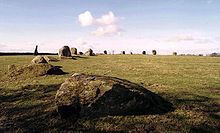 The monolith Long Meg (on the horizon at top left) and the southern arc of the circle | |
| Location | Little Salkeld grid reference NY571372 |
|---|---|
| Coordinates | 54°43′41″N 2°40′04″W / 54.72794°N 2.66765°W |
| Type | Stone circle |
| History | |
| Periods | Neolithic |
| Site notes | |
| Public access | Yes |
Long Meg and Her Daughters is a Neolithic stone circle situated north-east of Penrith near Little Salkeld in Cumbria, North West England. One of around 1,300 stone circles in the British Isles and Brittany, it was constructed as a part of a megalithic tradition that emerged during Neolithic, and continued into the Early Bronze Age (circa 3200 - 2500BC).[1]
The stone circle is the third widest in England, behind Avebury in Wiltshire and Stanton Drew in Somerset. It consists of 66 stones[2] (of which 27 remain upright) set in an east / west oval configuration measuring 380 ft (120 m) on its long axis. There may originally have been as many as 77 stones, as this was mentioned by William Camden in the 16th century. Long Meg herself is a 12 ft (3.7 m) high monolith of red sandstone 80 ft (24 m), standing to the southwest of the circle. The stone is marked with examples of megalithic art including a cup and ring mark, a spiral, and rings of concentric circles.[3][4][5] This art mirrors examples from Neolithic Ireland, including the contemporary Newgrange.[6] The composition and position of the stone is similar to that of the Altar Stone, at Stonehenge, and may be part of a similar tradition of using red sandstone to mark the solstice.[7]
Infra-red aerial photography has identified several Early Neolithic enclosures. These include a so-called 'super henge', a possible cursus monument, and a henge similar to examples found near Millom to the far west of Cumbria.[8] These appear to pre-date the stone circle, and its northern edge dips to avoid the lost ditch. There is also the smaller kerbed burial mound of Little Meg to the north.[9]
